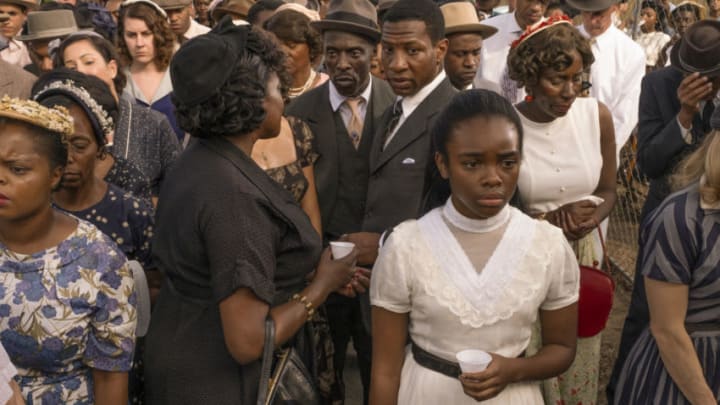Lovecraft Country’s “Jig-a-Bobo” doesn’t shy away from the horror of Emmett Till’s murder and its effect on his generation of young Black Americans.
In Horror Noire, a 2019 documentary about the history of Black horror, Tananarive Due stated that Black history is Black horror. Lovecraft Country depicted the reality of that statement in “Jig-a-Bobo” with the wake of Emmett Till.
The episode opens on Saturday, Sept. 3, 1955, as our heroes stand in line waiting to view Till’s body at Robert’s Temple. Since episode 3 — “Holy Ghost” — the audience has known him as Bobo, Diana’s friend who was excited to be going on a trip with his family to Mississippi.
For those who noticed Bobo’s historical significance early on, it’s been a slow wait wondering how Lovecraft Country was going to tell the story of what happened to Till within its universe. The answer, typical of this series, is that they chose to confront that history head-on.
The line the characters are standing in is a part of a massive crowd. According to the Chicago Daily News, “[by] the thousands the curious went to Robert’s Temple Church of God…and filed past the casket,” on the Southside of Chicago in Bronzeville.
The reporter covering Till’s funeral estimated that “50,000 people viewed the body in the chapel Friday night, and another 10,000 saw it before services began Saturday.”
Over the course of four days, until Till was laid to rest on Sept. 6, 1955, an estimated 100,000 people viewed his body.
Till’s murder sparked the birth of the “Emmett Till Generation,” a term coined by Joyce Ladner, a civil rights activist and member of the Student Nonviolent Coordinating Committee (SNCC).
Based on an oral history interview the Library of Congress conducted with Ladner and her sister, Dorie, the Emmett Till Generation is defined as “the African American baby boomers in the South who were inspired by Till’s murder to join a burgeoning movement of mass meetings, sit-ins, and marches to demand their equal treatment under the law.”
The anger the audience sees in Diana in “Jig-a-Bobo” can be interpreted as a part of her grief for her best friend, but also a manifestation of the anger many of her generation came to feel in the wake of Till’s murder and the subsequent acquittal of his murderers, Roy Bryant and J.W. Milam.
The two men beat Till for allegedly whistling at Bryant’s wife, Carolyn, a lie that would balloon into allegations of assault by the time she was interrogated. Then they shot him before tying barbed wire and a 75-pound metal fan around his neck that would drag him to the bottom of the Tallahatchie River after they dumped him in.
According to historian Dave Tell, the Mississippi government tried to keep Till’s story from becoming national news. In a piece for The Emmett Till Memory Project, Tell wrote:
"The casket arrived [to the funeral home] locked, sealed with the state seal of Mississippi, and accompanied by orders that the casket was not to be opened. If the Mississippi authorities could not bury the body in a nameless cotton field, they hoped their seal would keep Till’s story under wraps. It did not work."
Till’s mother, Mamie Till-Mobley, refused the direction of having a closed casket funeral. She said, “Let the world see what they did to my boy,” and allowed the Black press to take photos of her son. One of those photographers was David Jackson who accompanied Simeon Booker, a journalist for JET magazine to Till’s viewing.
It should be hard to believe that even with the photographic evidence of the brutal and horrendous crime Bryant and Milam committed against Till that the two men didn’t face any consequences, but it isn’t.
Lynchings in America haven’t stopped. Black Americans are still being murdered with near impunity in their homes, while they’re exercising, while they’re sleeping, when they’re walking home, and during routine traffic stops.
Murders are being carried out by the police and regular American citizens who say they felt threatened or scared or in fear for their lives, excuses that have been given credibility time and time again even when the evidence isn’t on their side.
What is sorrowful about revisiting Emmett Till’s murder in the year 2020 — 65 years after the crime — is that we are in the middle of another summer of riots, a phenomenon Martin Luther King Jr. attributed to “our nation’s winters of delay.”
We are in a new century, decades removed from the Civil Rights Movement, and we are still struggling as a nation with equity and the belief that Black lives matter. That’s not only disappointing, it’s disheartening.
For more of our Lovecraft Country coverage, follow our Lovecraft Country category and check out our podcast, Lovecraft Country Chronicles for recaps and reactions!
